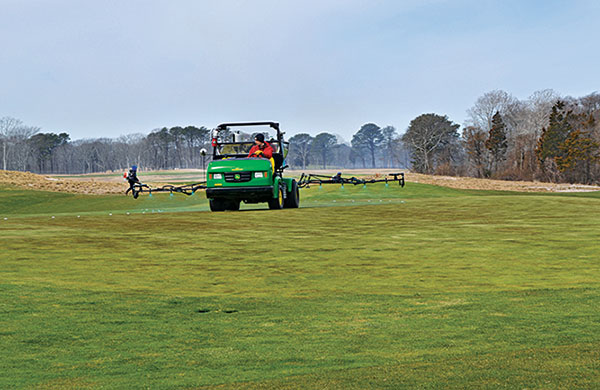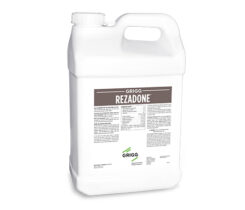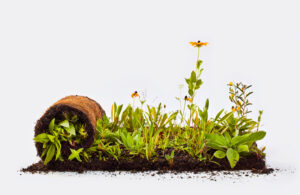Experts’ Insights: Fall fertilization frenzy

Fall fertilization on cool-season turfgrass ensures that the grass is healthy before it goes dormant for the winter. (Photo: Golfdom Files)
One of the keys to healthy grass in the spring is to make sure it’s in good health before going dormant in the fall. One way to ensure this is to implement a fall fertilization program. Fall fertilization improves plant health, increases density and vigor and extends the green color of the turf.
According to Kevin Frank, Ph.D., professor and Extension turf specialist at Michigan State University, cooler temperatures and precipitation in the fall produce ideal growing conditions for cool-season turfgrasses. “Fertilization during this time,” he says, “often results in improved growth, density and color, along with what you don’t see, such as carbohydrate accumulation in the plant.”
“Physiologically, (fall) is one of those times that a plant is sort of in the sweet spot because the weather conditions are optimal for the plant to be most efficient with those nutrients,” notes Cale Bigelow, Ph.D., professor of agronomy at Purdue University.
Frank prefers a strategy of spoon feeding throughout the fall months or fertilizing earlier on fairways and roughs instead of applying fertilizer at the end of the season. However, Bigelow notes the benefits of late fall (Oct. 15-Nov. 15) fertilization.
“That’s important because it affects your source of nutrients,” he says. “In the fall fertilization, you might be using slow-release nitrogen, while in late fall, it’s quick-release or water soluble.”
Bigelow says he sees more superintendents playing around with water-soluble nitrogen and applying it as a liquid. According to Frank, one of the biggest changes he’s seen in the last 20 years or so is moving up the application of fertilizer to September or October or spoon feeding throughout the fall.

Bob Hartman
Knox Fertilizer Co.
Bob Hartman
Director of Sales and Marketing
Fertilizing in the fall provides important characteristics for the health and survival of turf. In most instances, especially in cool-season turf, summer stress has taken its toll, and turf needs help recovering, building the root system and preparing itself for the long winter ahead. In other parts of the country, warm-season grasses also go into dormancy, so they too benefit from the fall application. Additional potassium helps both the cool- and warm-season grasses store energy over the winter and promotes a quicker spring green-up the following year. Fall fertilization helps maintain a green color longer into the winter. Using additional potassium in the fall helps turf store water and increases stress tolerance associated with the long, hot summer and impending winter. While the best time to fertilize can vary based on geographic region and turf varieties, the optimal time would be when the temperature drops. The roots are still active, but the growth of turf shoots has slowed. Golf courses typically have annual fertilization programs, but if a superintendent were to fertilize only once a year, fall is the best time to do it. I can’t imagine someone not fertilizing in the fall.

Chris Derrick
Koch
Chris Derrick
Field Sales Agronomist
To prepare for winter dormancy, the plant’s physiology transitions from an actively growing state to one where it’s storing carbohydrates for later use as an energy source. By fertilizing turf in the fall, you’re providing it with nutrients it can store away for the next growing season. You’re going to see quicker green-up in the spring for a better-looking course earlier in the season. Fall fertilization also improves shoot density and root growth. The timing of the application depends on weather patterns and climatic conditions that affect temperature and its role in plant function. There may be the need for an early fall application intended for summer stress recovery or later in the fall for winter preparation. The best time to fertilize is when turf is still green, but growth has slowed or even stopped. Simply speaking from my experience, when best management practices as well as The Fertilizer Institute’s 4 R system are factored into the decision-making process, the need to fertilize only applies if the plants need it.

Gordon Kauffman
Brandt
Gordon Kauffman, Ph.D.
Technical Manager
Early fall fertilization will encourage turfgrass vigor. When soil temperatures cool, spoon feeding will facilitate the hardening-off process. A complete and balanced fertilizer program will offer the best results. When applied correctly, you’ll see accelerated shoot and root growth, better color, increased tillering and enhanced recovery from mechanical damage or cultivation. Early autumn signifies the best time for golf course superintendents to aggressively apply nutrients to cool-season turfgrasses. Focus on larger doses of nitrogen (N) during this time. Nutrient demand declines on soils with higher exchange capacity. Decrease N inputs in midfall to encourage carbohydrate allocation to turfgrass roots. Consult a soil test to determine specific nutrient needs.

Anthony Goldsby
The Andersons
Anthony Goldsby, Ph.D.
Research Agronomist
The focus of fall fertilization is on rejuvenating and recouping that grass ahead of winter and the following spring. When superintendents put fertilizer out in the spring and summer, they associate that with growth at the top of the plant. In the fall months, a lot of that energy is put down into the roots. You’re going to get a deeper root system and food reserves for the plant. You’ll get later color retention into the fall, and the following spring, they’re going to green up quicker. Most people are going to start in September or October and go until maybe Thanksgiving. When you’re getting temperatures below 65 degrees F, you get that energy going down into the root instead of shoot growth. There is not an instance when fall fertilization would not be necessary. If you’re going to skimp out on fertility or don’t have the budget for it, I would recommend removing it from the summer or not doing a springtime application. Fall, especially for cool-season turf, is really the most important part.











